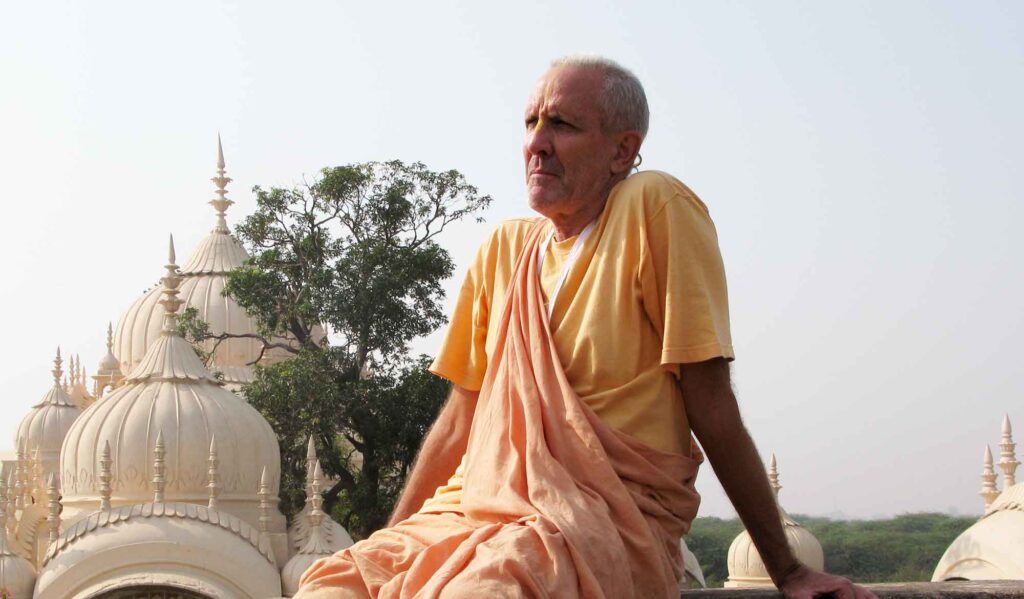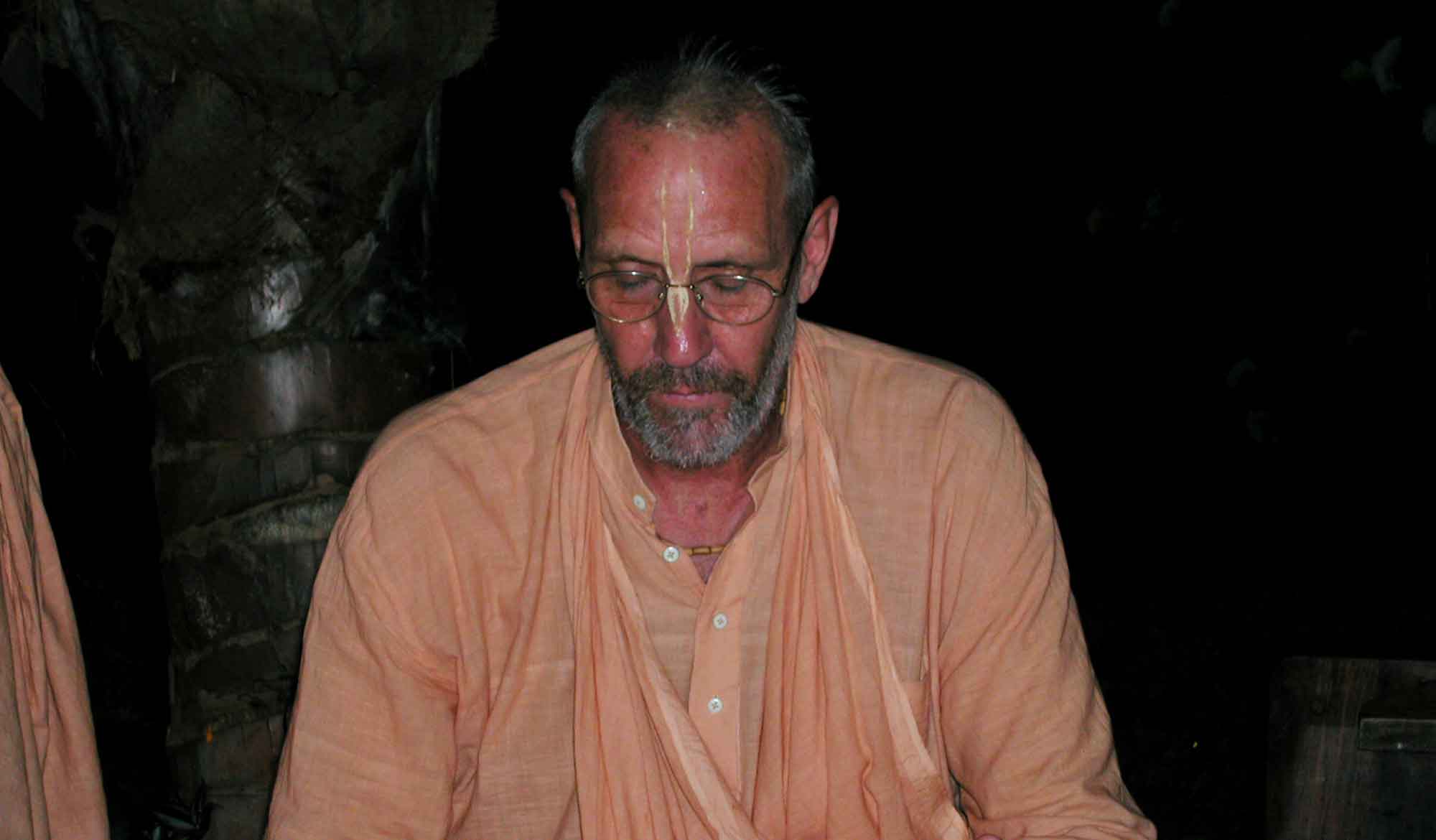by Swami B.G. Narasingha
“Gītā Govinda of Jayadeva Gosvāmī” was written by Śrīla Narasiṅgha Mahārāja in September 2005. This article addresses a particular group of devotees who published an English translation of Gītā Govinda, who begged the question that is was necessary to distribute this high literature to one and all.
Question: I purchased a copy of Gītā-Govinda from a devotee selling books in the streets of Bangalore (India) with a foreword by Śrīla Bhaktisiddhānta. My question is, are we to understand that Bhaktisiddhānta has authorized the reading of Gītā-Govinda for the devotees and the general public?
Swami Narasiṅgha: So far as the Gītā-Govinda is concerned, Bhaktisiddhānta did not allow his disciples to read Gītā-Govinda nor did he ever write a foreword to that book.
I am aware of the Gītā-Govinda publication that you speak of and it is quite misleading that the publishers have posed Śrīla Bhaktisiddhānta as having written that article expressly for Gītā–govinda. Had he actually written a foreword to Gītā–govinda, then it would indeed be an authorization for devotees in his paramparā to read that book, but he has not.
It is a misnomer since the article presented there as a foreword by Bhaktisiddhānta was actually not written by Bhaktisiddhānta. The article was originally written by Professor Nishikanta Sanyal and published in The Harmonist magazine volume 26 #6 in November 1928 (it was later published as a small booklet in 1931). The article was originally called, “The Erotic Principle and Unalloyed Devotion” and has been printed and mistakenly attributed to Bhaktisiddhānta in many Gauḍīya Maṭha publications over the decades.
The so-called ‘Forward to Gītā–Govinda’ is actually Professor Sanyal’s article with a two paragraph add-on at the beginning taken from a lecture by Bhaktisiddhānta wherein he speaks briefly about Jayadeva Gosvāmī. But he does not recommend the reading of Gītā–Govinda. The two paragraphs by Bhaktisiddhānta and the article by Professor Sanyal were never intended to be an introduction to Gītā–Govinda and to do so is misleading and misrepresenting our ācārya.
So the topic that you have raised must be taken as interpolation – the fact of the matter is that Bhaktisiddhānta did not write a foreword to Gītā–Govinda nor did he allow his disciples to read Gītā-Govinda nor did his bona-fide disciples recommend Gītā–Govinda to be read by their disciples.
The fashion of pseudo-Vaiṣṇavas has always been to acquire information about Kṛṣṇa’s līlā and then to make a show of such knowledge to attract the innocent or ignorant devotees and public.
Bhaktisiddhānta, however, was quite a different person – he placed full importance on surrender and the serving disposition – first deserve, then desire. He was also not in favour of trying to be something or someone in Kṛṣṇa consciousness that you are not. In other words, first one must purify one’s heart from all material tendencies by chanting the Holy Name of Kṛṣṇa before one is qualified to hear higher topics in Kṛṣṇa’s līlā. When a neophyte devotee delves in the higher līlās of Kṛṣṇa without being properly qualified he makes offences and is in due course cast down. Bhaktisiddhānta therefore wanted his disciples to make real advancement in Kṛṣṇa consciousness and he guided them accordingly.
To read Gītā–Govinda without proper qualification is an offence and to distribute it to the innocent or ignorant public in the name of preaching is also an offence.
I will provide here some quotes on this topic from ācāryas and renowned Vaiṣṇavas so you may better arrive at the proper conclusion on this matter.
“Our master did not allow us to read the books where the higher līlās are described – Govinda-līlāmṛtam, Stava-kusumāñjali, Ujjvala-nīlamaṇi, and Gītā–Govinda. He did not allow us to study and to discuss them. Rather, he would be very much disturbed if he heard that someone was interfering with the higher līlās in those books. He did not like it.
“There are three chapters of Śrī Caitanya-caritāmṛta that we were generally not allowed to discuss fully, including the conversations with Rāmānanda Rāya. Where the līlā portion of Radha-Govinda is mentioned, we were not to delve. Of course when parāyaṇa (consecutive chanting of the whole book) was taking place, we were to go on reading those sections, but without giving any particular attention to the līlā of the highest order of raga. That was barred: “Don’t try to come into details there. That will come automatically when it is time. Do not make it a public discussion. Do not place it in the public eye.”
“Duṣṭa-phala karibe arjjana – Śrīla Bhaktivinoda Ṭhākura warns that we will get only a bad result if we venture to cross that line. It is aparādha. From the lower position, the steps are shown – śraddhā, sādhu-saṅga, śravaṇa, kīrtana, then anartha-nivṛtti, when the undesirable things vanish. Then comes ruci, then asakti, then bhāva–bhakti, the sprout of real devotion. Then prema–bhakti, and sneha, mana, praṇaya, rāga, anurāga, bhāva, mahā-bhāva – by such steps we are to approach the highest plane.” (Śrīla B. R. Śrīdhara Deva Gosvāmī, Follow the Angels, Ch-2)
“Gītā-Govinda is a special poetry book, full of transcendental mellows of devotional service, and it describes the exalted pastimes of the Supreme Brahman. There is no other such book in the world. Since the ordinary readers cannot realize the conjugal mellows of the Supreme Lord and since they are fond of material enjoyment, their study of Śrī Gītā-Govinda is not perfect. The poet Jayadeva Gosvāmī has not offered his book to such readers; rather he forbade them to study this book. For persons who are inexperienced in the transcendental mellows of Vraja, discussing Jayadeva Gosvāmī and his work is proof of their shamelessness.” (Bhaktivinoda Ṭhākura, Sajjana-tośaṇī 7.2)
“With the dissolution of mundane desire, an intense urge arises to serve the senses of Madana-mohana, the transcendental Cupid who enchants the mundane Cupid with His beauty. It is only at this point in one’s spiritual development that one will be able to properly engage in the practices of rāgānuga–bhakti such as hearing, chanting and meditating on the aṣṭa-kālīya līlās. As long as material desires are present in the heart, it is very possible that a concerted effort to enter into erotic subject matter such as those described in Jayadeva’s Gītā-Govinda will have inauspicious results.” (Śrīla B.P. Purī Mahārāja, The Art of Sādhana, Chapter 1)
“It is premature to think that as soon as one has taken shelter of his spiritual master he has the right to relish books like the Bhāgavata’s Rasa-pañcādhyāya, Gopī-Gītā, Uddhava-samvāda, or Govinda–līlāmṛta and Kṛṣṇa-bhāvanāmṛta, the songs of Caṇḍīdāsa and Vidyāpati, Jagannātha-vallabha-nāṭaka, Kṛṣṇa-karṇāmṛta, Gītā-Govinda, and other books of this type. The inevitable consequence of such precocious entry into the subjects of Krishna’s conjugal pastimes is that one falls into illicit sexual activity.” (Śrīla B.P. Purī Mahārāja, The Art of Sādhana)
“The Gītā–Govinda, the loving affairs of Rādhā and Kṛṣṇa, it is not for the neophyte student… If you are actually advancing in devotional service, then the symptom will be that you’ll have no more material hankerings.” That is real. So if you actually hear about Kṛṣṇa’s pastimes with Rādhārāṇī, then hṛd-roga-kāman apahinoti, then our heart disease, lusty desires, will vanish. That is the result. I have repeatedly said. So if you become more lusty by seeing the pastimes of Kṛṣṇa with Rādhārāṇī or hearing, that means you are not fit. Stop it. Stop it. Don’t be foolish.”(A.C. Bhaktivedānta Swami Prabhupāda, Lecture on Caitanya-caritāmṛta Ādi-līlā 1.6, Māyāpura, March 30th, 1975)
Actually, you will not find anywhere any quotes from our ācāryas or renowned Vaiṣṇavas recommending that one who is unqualified should hear about the advanced līlās of Kṛṣṇa. All our ācāryas recommend that first one has to become free from anarthas, free from material contamination. Only the sahajiyās and publishers of Gītā-Govinda have the audacity and foolishness to cross the instructions of Śrīla Bhaktisiddhānta.
It is indeed a ruse when the publishers of Gītā–Govinda say that if the followers of Bhaktisiddhānta do not translate and comment upon Ujjvala–nīlamaṇi, Gītā–Govinda, etc. that these books will then be the exclusive property of the sahajiyās. To the contrary, in doing so, the publishers of Gītā-Govinda have entered the domain of the sahajiyās and shown us their true colours.
At a time when pseudo-Vaiṣṇavas gave faulty instructions in the name of the teachings of Śrī Caitanya, Bhaktisiddhānta rose above the crowd and by his preaching, and his personal example, he gave real life to Gauḍīya Vaiṣṇavism. His instructions are thus for all time, all places, and all circumstances – because he directly represents the desire and teachings of Śrī Caitanya. Bhaktisiddhānta gave real life to Gauḍīya Vaiṣṇavism and to reject his instruction means to suffer a spiritual death no matter how much one thinks he knows about Kṛṣṇa.
More Articles by Swami B.G. Narasingha
The Sacred River Sindhu/Indus
‘The Sacred River Sindhu/Indus’ was posted by Swami B.G. Narasingha on his blog, narasingha.net, on October 2nd, 2011. In this short article, Narasingha Maharaja explains the significance of the River Sindhu and his pilgrimage to it. This article was later expanded into a bigger article called ‘Sindhu River – How India Got Her Name.’
Instructing the Guru
This article “Instructing the Guru” was written in April 2018 by Śrīla Narasingha Mahārāja who answers a question concerning a previous article wherein a Vaiṣṇavī writes a letter to her dīkṣā-guru and explains to him about the importance of śikṣā. In response, a question was raised by a devotee about the etiquette of a disciple instructing her guru.
The Atomic Ray – From Uniform Consciousness to Individual Conscious Units
In “The Atomic Ray - From Uniform Consciousness to Individual Conscious Units” written in 1996 Śrīla Narasiṅgha Mahārāja discusses the constitutional position of the jīva, according to Bhaktivinoda Ṭhākura and Śrī Caitanya-caritāmṛta.













